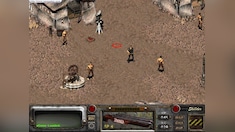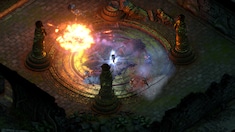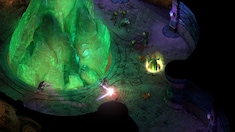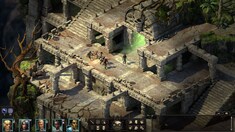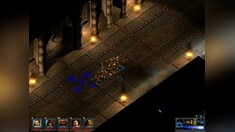Some of the highest praised video games in history have been turn-based role-playing games. The genre has its loyal fans and is one of the most esteemed among the game critics and journalists. What is the phenomenon of these games, is it the plot, or maybe the gameplay?
In this article, we will present the best turn-based RPG games of all time and explain the reasons behind the popularity of such games. So, without wasting more time, on to the list!
| Game | Release | Genre | |
|---|---|---|---|
 | Arcanum: Of Steamworks and Magick Obscura | 2001-08-22 | RPG |
 | FINAL FANTASY IX | 2016-04-14 | Adventure |
 | FINAL FANTASY X/X-2 HD Remaster | 2016-05-12 | RPG |
 | FINAL FANTASY XV WINDOWS EDITION | 2018-03-06 | RPG |
 | FINAL FANTASY XIV: Shadowbringers Final Fantasy | 2019-07-02 | RPG |
 | FINAL FANTASY XIII & XIII-2 | 2014-12-11 | Adventure |
 | Pillars of Eternity II: Deadfire - Obsidian Edition | 2018-05-08 | RPG |
 | Shadowrun: Dragonfall - Director's Cut | 2014-09-18 | Adventure |
 | South Park: The Stick of Truth | 2014-03-06 | Adventure |
 | South Park The Fractured But Whole | 2017-10-17 | Adventure |
 | The Temple of Elemental Evil | 2003-09-16 | Adventure |
 | Wasteland 2: Director's Cut - Classic Edition | 2014-09-18 | Indie |
 | The Bard's Tale IV: Barrows Deep | 2018-09-18 | RPG |
 | Divinity: Original Sin - Enhanced Edition | 2015-10-27 | Adventure |
 | Divinity: Original Sin 2 | Definitive Edition | 2017-09-14 | Adventure |
 | Fallout Classic Collection | 1997-11-01 | Adventure |
 | Fallout 2 | 1998-12-01 | Adventure |
Arcanum: Of Steamworks and Magick Obscura
| Release date: | 2001-08-22 |
Arcanum: Of Steamworks and Magick Obscura is one of the classics, if sadly somewhat forgotten, isometric RPGs, released by Troika.
2001 was a time when the infinity Engine games were at the height of their relevance, but Arcanum managed to grab a bit of attention as well, not least because it offered a dual combat system: real-time with pause and turn-based, depending on the player’s preference.
The turn-based combat operates on action points, and what you can do is decided in large part by the place you’re in on the magic-technology axis. That axis is important to the game: the closer you get to either extreme, the less effective and potentially more dangerous to use items and abilities bound to the opposite side. Get too technical, and not even healing magic will work on you, for example.
| Key features |
|---|
|
The Bard's Tale IV
| Release date: | 2019-08-27 |
The latest installment of the classic, pre-Infinity Engine dungeon crawler-style RPGs.
The Bard’s Tale games of old are a definitive part of the genre history. Although you’re seeing the world for the first-person perspective, you’re actually moving as an entire party of adventurers going about their adventuring business, full of dungeons, puzzles, and deadly enemies.
In The Bard’s Tale IV’s combat positioning is very important, especially when there re spellcasters hiding behind enemy ranks. You start with a team of up to four, but in time it will grow to six characters, and picking the right ones will be quite important because the enemies won’t play nice with a poorly managed group. It’s one of the best dungeon crawling experiences in recent years.
| Key features |
|---|
|
Divinity: Original Sin 1 & 2
| Release date: | 2014-06-30 / 2017-09-14 |
Kickstarted successes of both installment of the Original Sin line of Larian Studios’ long-running Divinity series really put the Belgian developer on the map of turn-based, fundamentally tactical RPGs.
The iconic feature of these games are the interactions between various systems, most notably, and explosively, the various elements available through magic, grenades and enchanted weapons.
Original Sin 2 introduced the Magical and Physical armor system, which required you to whittle down enemy defenses before you get to inflict most statuses or any health damage at all, and magic was expanded with schools such as Polymorph, which transforms a character’s body to give them wings, a grasping tentacle arm. There’s also a strictly PvP/PvAI Arena mode, just about battles.
| Key features |
|---|
|
Fallout 1&2
| Release date: | 1998-12-01 |
The original Fallout games are a beloved part of RPG history and well-deservedly so.
Set in a harsh, yet oddly lively, post-apocalyptic setting, the Fallout games give the players a large degree of freedom in how they aim to accomplish their goals. The world in either game is freely explorable via an overworld map and is steadily filled with locations as you randomly discover them or get the coordinates.
Although normally you’re free to move unrestricted through locations, once combat starts it happens in turns ruled by Initiative, action points, and hexagonal map. Depending on your weapon you might get different attack options, such as a single bullet and burst with a gun, a throw and throw with a spear etc., and there are tangible benefits to making aimed shots, including instant kills.
| Key features |
|---|
|
Final Fantasy series
| Release date: | 1987 (first game) |
The Final Fantasy series began with fully turn-based battles, which eventually morphed into something more dynamic and flexible.
Despite that shift, many, if not most, installments of the series are readily available and quite playable on modern systems. And that includes the recently released Final Fantasy VII Remake, which despite hack’n’slash combat still has shades of the ATB system.
Over thirty years of the series’ history resulted in fifteen mainline original games, each taking place in a new setting, some of them rooted in fantasy, others leaning towards science-fiction, many merging both. And most fall on the spectrum of turn-based combat, with some exceptions like FF14 for example. And all tend to be really good, especially if you don’t dislike the animesque aesthetic.
| Key features |
|---|
|
Pillars of Eternity II: Deadfire
| Release date: | 2018-05-08 |
Although Pillars of Eternity 2: Deadfire didn’t launch with a turn-based system in place, it got added in a patch some months after release and turned the game into a whole new experience.
By default, PoE2 resembles the classic Infinity Engine games like Baldur’s Gate, although the system is quite different: Obsidian’s original, and better suited for real-time gameplay.
When the turn-based mode came, it required big rewrites to large chunks of the system but made the battle feel much more ordered and readable. It works really well, and as a nice bonus it gives the player enough time to appreciate the visual effects of various abilities, especially spells. Unfortunately, to play in either mode you need to start a new game, no switching mid-way through.
| Key features |
|---|
|
Shadowrun: Dragonfall
| Release date: | 2014-09-18 |
Dragonfall was so big and developed that Harebrained Schemes decided to make it a full game instead of a DLC to Shadowrun Returns.
That’s how good it is. Set in the Shadowrun setting, which mixes cyberpunk-style near-future urban setting with fantasy elements like elves, trolls, or magic. You control a group of shadow-runners who stumble across a conspiracy threatening much of Europe.
Being based on an already turn-based by nature Shadowrun role-playing game, Dragonfall neatly translated the tabletop mechanics into a video game. Even the way hacking looks in the game is essentially a turn-based battle between hackers and the programs they deploy. Most notably, however, each battle ties strongly into the story, with few, if any, filler fights.
| Key features |
|---|
|
South Park: The Stick of Truth & South Park The Fractured But Whole
| Release date: | 2017-10-17 |
These two games are hardly the first games based on the long-running irreverent cartoon, but it’s safe to say that they are the first to be unequivocally good.
Both are turn-based, and unmistakably RPG, but they approach the topic differently. Stick of Truth battle works like in a jRPG, with characters static on the map, while in Fractured But Whole they got to move across a tactical grid.
The theme for the first game was a city-wide fantasy LARP (Live-Action Role-Playing), lovingly mocking the tropes of fantasy stories and the logic of RPG games. The sequel, made by a different developer, changed the topic to superheroes and mocked them with the same relentless energy. It was inevitable, given the strong involvement of South Park’s creators Trey Parker and Matt Stone.
| Key features |
|---|
|
The Temple of Elemental Evil
| Release date: | 2003-09-16 |
Temple of Elemental Evil, sharing the title with a classic adventure from the early years of Dungeons and Dragons, was the first D&D-based game since Baldur’s Gate 1 to feature turn-based battles.
And it was unfairly forgotten because combat was great, and the accuracy with which ToEE represented the D&D ruleset was admirable and unseen during the glory days of Infinity Engine.
As D&D mechanics designed for an inherently turn-based tabletop experience, they translated smoothly into a turn-based video game without much tweaking. The story is simple: a temple dedicated to a powerful evil god has grown near the town of Hommlet, and the region peaceful for so long is troubled by bandits and monsters. This is where your group of adventurers comes in.
| Key features |
|---|
|
Wasteland 2
| Release date: | 2014-09-18 |
A sequel to the game inspired the original Fallout, Wasteland 2 is a successful revival of the classic tactical RPGs from 1988.
The game takes place in a post-apocalyptic world, ruined by a 1998 nuclear war between the USA and the Soviet Union, and the player controls a group of Desert Rangers sent to investigate a murder of one of their own, who was sent to investigate a strange transmission.
The player has a team of four personalized characters first generated at the beginning of the game, but there’s also room for up to three recruitable NPCs. A party of seven is a lot but the world is brutal and it’s very likely that you’ll encounter unfair odds. Performance in battle and outside of it, as befits and RPG, will result in different endings, showing how the characters affected each visited city.
| Key features |
|---|
|
What are the turn-based RPG’s?
Role-playing video games tend to fall into two broad categories these days. One is occupied by the party-based affairs, often with isometric camera and battles governed by carefully hidden turns or using short-timers to determine the speed of attacks and the time given characters get to act again.
Games like Pillars of Eternity and Dragon Age: Origins belong in this category. The other type of RPGs is much more action-focused and tend to be solitary adventures. You’ll tap a button do dodge an attack, press a button to make an attack, and generally engage with the enemies in a dynamic, response manner, and one that requires some reflexes. It’s the kind of game that The Witcher 3, Skyrim, and Mass Effect fall into. But there is also the third type, a rarer one, that exists and pops up every now and then. It’s an RPG with turn-based battles.
One thing that can be certainly said of turn-based battles is that they make battles between two (or more) parties less chaotic and more tactical. Having to deal with initiative order also requires changing the way you plan, because some cheesing methods like kiting won’t work. There’s also the fact that run-based systems are better for adaptations of natively turn-based tabletop RPGs, as one of the games on the list below proves.
Your turn
This marks the end of the list of RPGs which decided to give turn-based combat a chance. Hopefully, you’ve found one that appeals to you, or at least convinces you to keep an eye for new ones being developed and announced, such at Baldur’s Gate 3, a turn-based sequel to a classic series from the turn of the millennium.




















